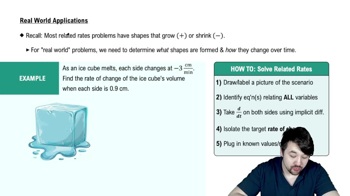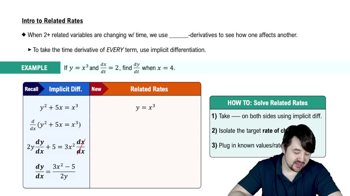Table of contents
- 0. Functions7h 52m
- Introduction to Functions16m
- Piecewise Functions10m
- Properties of Functions9m
- Common Functions1h 8m
- Transformations5m
- Combining Functions27m
- Exponent rules32m
- Exponential Functions28m
- Logarithmic Functions24m
- Properties of Logarithms34m
- Exponential & Logarithmic Equations35m
- Introduction to Trigonometric Functions38m
- Graphs of Trigonometric Functions44m
- Trigonometric Identities47m
- Inverse Trigonometric Functions48m
- 1. Limits and Continuity2h 2m
- 2. Intro to Derivatives1h 33m
- 3. Techniques of Differentiation3h 18m
- 4. Applications of Derivatives2h 38m
- 5. Graphical Applications of Derivatives6h 2m
- 6. Derivatives of Inverse, Exponential, & Logarithmic Functions2h 37m
- 7. Antiderivatives & Indefinite Integrals1h 26m
- 8. Definite Integrals3h 25m
4. Applications of Derivatives
Related Rates
Problem 52a
Textbook Question
An angler hooks a trout and begins turning her circular reel at 1.5 rev/s. Assume the radius of the reel (and the fishing line on it) is 2 inches.
a. Let R equal the number of revolutions the angler has turned her reel and suppose L is the amount of line that she has reeled in. Find an equation for L as a function of R.
 Verified step by step guidance
Verified step by step guidance1
Identify the relationship between the number of revolutions R and the length of the fishing line L that is reeled in. Each complete revolution of the reel corresponds to a certain length of line being pulled in.
Calculate the circumference of the reel using the formula for the circumference of a circle, which is C = 2πr, where r is the radius of the reel. Here, r = 2 inches.
Express the length of the line L in terms of the number of revolutions R. Since each revolution reels in a length equal to the circumference, we can write L = C * R.
Substitute the expression for the circumference from step 2 into the equation from step 3 to get L as a function of R: L = (2π * 2) * R.
Simplify the equation to express L in a more compact form, resulting in L = 4πR, which shows the direct relationship between the length of the line and the number of revolutions.
Recommended similar problem, with video answer:
 Verified Solution
Verified SolutionThis video solution was recommended by our tutors as helpful for the problem above
Video duration:
2mPlay a video:
Was this helpful?
Related Videos
Related Practice






